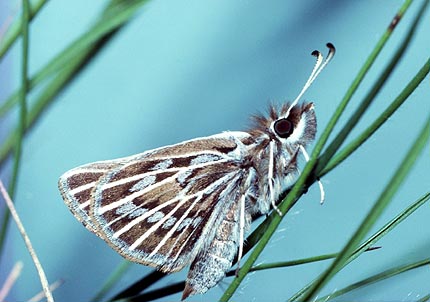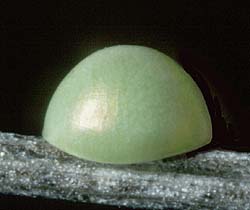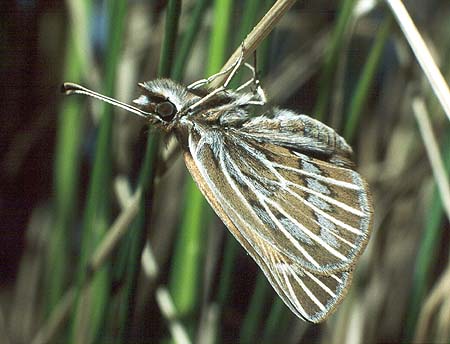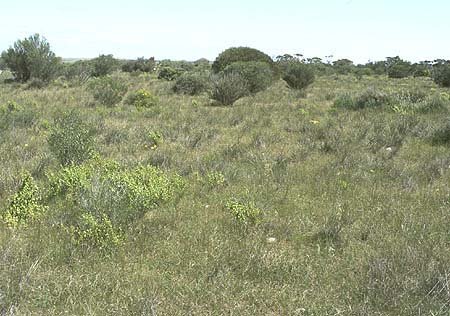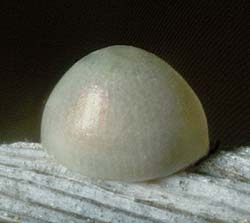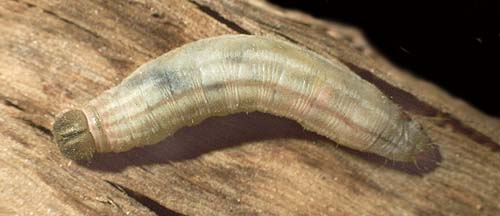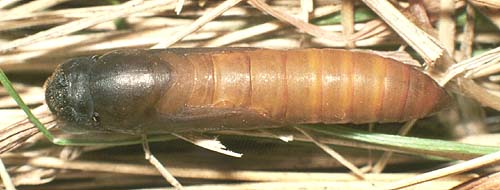-
Larval Food Host
-
The perennial Austrostipa eremophila (desert spear-grass),
A. scabra (rough spear-grass),
A. scabra falcata (delicate spear-grass),
A. semibarbata (fibrous spear-grass) (Poaceae).
The larvae eat the leaves of the foodplant, which apart for A. semibarbata,
are wiry leaved. (The identity of the broad-leaved A. semibarbata as a foodplant
needs reconfirmation.)
-
Eggs
-
Large, pale green, hemi-ellipsoid with numerous very indistinct vertical ribs,
laid singly on the foodplant. The eggs do not acquire red markings if fertile.
Eggs are only laid on a dead portion of the foodplant situated in full sun.
In situations where the egg is wider than the dead grass stalk upon which it
has been laid, the base of the egg will wrap itself around the stalk during
the hardening stage of the egg. Larval development within the egg commences
immediately after being laid, and larvae begin to emerge after about two weeks.
The egg shell is eaten by the larva after its emergence.
-
Larvae
-
Initially pale yellow, with a large slightly rugose, shining black head with a few
long hairs, the neck (prothoracic plate) is black, and long recurved hairs occur
posteriorly. The larvae gradually turn green after eating the foodplant.
After eating the egg shell, the young larvae move off to the growing parts of the
foodplant and make small shelters by silking together several leaves or stems
within the lower parts of the foodplant. Later instars construct larger, more
elaborate upright shelters within the congested lower parts of the foodplant,
by loosely silking together many stems.
The final instar is long cylindrical shaped, about 18-25 mm long, slightly thickened
in the middle, with the last posterior segment flattened into the anal plate, smooth,
but with the posterior end having some hairs. The head is large, finely rugose, rounded,
there is an indistinct central longitudinal furrow, noticeably hairy with pale coloured
hairs that are simple and pointed, with longer hairs laterally, but those hairs on the
front being bent and directed forward. The body colour is variable from pale brown to
pale yellowish brown to pale yellowish green, with a darker dorsal line, and a further
two pairs of indistinct darker longitudinal subdorsal lines. The area in between the
brown lines is infilled a pale whitish colour. The anal plate and neck are finely
speckled black. The head is pale brown with a dark brown or black frontal vertical
mark above the mouth edged laterally pale yellowish brown, and the mouthparts are dark
brown or black. The body, and particularly the anal plate on the last segment, have
some tiny secondary setae. Along the body they are elongate vase shaped set on transparent
simple raised bases. On the anal and prothoracic plates they are spinose with blunt
or pointed ends, set on black coloured raised bases.
The opening of the shelters is at the top, and the head of the larvae can often be seen
by looking vertically down into the foodplant. (Larvae of the cutworm moth also feed
on native grasses, and utilise the same grasses as the skipper. Larvae of both moth
and skipper look very similar, but the larvae of the skipper are differentiated by their
large rugose heads. Moth larvae have heads that are small, smooth and shiny. )
The skipper larvae feed briefly at night, hiding from predators during the day inside
their shelter. They grow slowly through the warmer months. However, the foodplants
in some areas often dry out during summer and the larvae then go into a torpid diapause
condition within their shelters, waiting for the autumn rains to produce a new flush of
growth. After receiving the rains, these larvae begin to eat again and continue to mature
and will pupate by the end of winter. If the preceding season is good and the grass
remains in a green condition, then larva maturity can be reached at the end of autumn
or early winter. Some of these larvae will then pupate, while others will become
quiescent and will individually pupate at different times during winter. Pupation occurs
inside the final larva shelter within the lower parts of the foodplant.
-
Pupae
-
Brown or dark brown, darker anteriorly, about 16-19 mm long, short cylindrical,
tapering posteriorly, nearly smooth without abdominal bristles, and the head
is rounded and rugose. The head cap (operculum) is black and brown coloured,
having a characteristic rounded shape, and there are many short brush-like
hairs (i.e. many hairs emanating from a single base). The central part of the
operculum is black coloured, heavily sclerotised (very rugose) and is divided
into a larger ventral, elevated part that is triangular or elliptical in shape,
and two smaller equal-sized dorsal parts that are set in a lower position.
The posterior end of the pupa tapers to a short, bluntly rounded, dark brown
cremaster.
Pupation occurs in the final larva shelter situated at the base of the foodplant,
with the head of the pupa directed upwards. The pupa is weakly secured within
the silk lined shelter by hooked bristles emanating from the terminal-ventral
portion of the cremaster. The pupal duration is variable, and can be as short
as two weeks in early spring. Those pupae formed at the beginning of winter will
obviously have a much longer wait for the early spring emergence.
Colonies of this skipper are often plagued by small, black, braconid parasitoid wasps
(Apanteles sp), which attack the larvae.
-
Flight Period in South Australia
-
It is single brooded with a short flight period during early spring of about one month
in each locality. The flight commences about two weeks earlier in northern Eyre Peninsula
compared to the eastern parts of South Australia. It overwinters as larvae and pupae.

-
Distribution
-
The skipper probably once occurred in a semi-continuous band across southern temperate
mainland Australia within the broad-acre Austrostipa grassland plains. This
habitat has now been extensively fragmented and abused due to agricultural and pastoral
development. Within South Australia the known range of the skipper presently extends from
the Upper Southeast, northward through the Murray Valley into the Mid North on the east
side of the Mt Lofty and Flinders Ranges. It is also known from central Yorke Peninsula,
northern Eyre Peninsula, and the Nullarbor Plain. Two other subspecies are recorded from
southwest Western Australia, and from inland NSW.
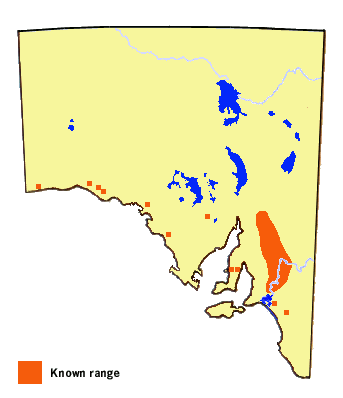
-
Habitat
-
The broad-acre temperate Austrostipa grasslands occurring within an annual
rainfall band of about 250-600 mm.
-
Conservation Status in South Australia
-
Vulnerable, bordering on rare. Many of the South Australian populations now
only exist on roadside verge.
-
Threats
-
This is a native grassland skipper and consequently has suffered considerably from
agricultural disturbance and the effects of overgrazing and trampling by stock.
These Austrostipa grasslands are also the prime breeding ground for the
plague locust
and the skipper has therefore been further decimated by the toxic spray programs
adopted by the Locust Control Board. Grass fires are also a severe local threat
as are the periodic droughts.
-
Conservation Strategy
-
Remaining native Austrostipa grasslands used for pastoral purposes need to
be managed in an ecologically sustainable manner. With more conservation awareness
and better pastoral management in the pastoral areas it is likely this skipper would
recover rapidly as it is very resilient and is well adapted to the dryland Austrostipa
grassland habitat. Failing this, specific grassland habitat may have to be conserved
for the long term survival of the skipper. Hopefully, new technology through the use
of a Metarhizium fungus to control the plague locust will see a lasting
improvement in the native grassland environment.
